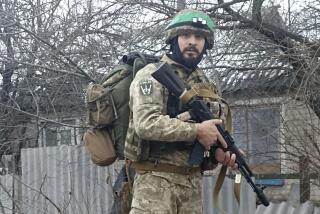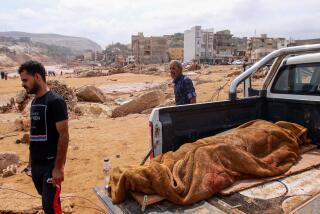Russian Rescue Teams Travel Far Afield
- Share via
MOSCOW — When Russia sent 76 people, two dogs and nearly 30 tons of equipment to help Colombia dig out from its recent earthquake, the Colombians were grateful, friendly and more than a little baffled.
Who were these people in ugly blue and orange jumpsuits who barely spoke Spanish, and why had they traveled halfway around the world to help a nation that had little to offer in return?
And isn’t Russia broke, anyway?
Well, yes. But lack of money hasn’t noticeably slowed down Russia’s Emergency Situations Ministry, a remarkable post-Soviet creation that has sent crack rescue crews all over the globe.
Earthquake rescues in Turkey, humanitarian aid to the former Yugoslavia, refugee resettlement in Rwanda--Russians are popping up in the strangest places these days.
“No matter how hard it is in Russia, Russia has to help those who have an even harder time,” explained First Vice-Minister Yuri Vorobiev. “Certainly, we can’t help on the same scale as the United States or Germany. . . . But this is a matter of principle.”
Principle--and principal. Russia earns desperately needed cash from some of these operations, carried out under contract with the U.N. High Commissioner for Refugees--whose acting chief in Russia, Victor Andreev, complains that “their prices are a bit on the high side.”
Still, in other cases such as the Colombia mission, which cost $176,000, Russia asks for and receives nothing.
The Emergency Situations Ministry--Emercom for short--is one of the most effective and popular agencies in Russia’s post-Soviet government, one of the few thus far untainted by allegations of corruption.
Most of its work is carried out within Russia, where the declining economy and crumbling infrastructure have created a fertile environment for disaster. Plane crashes, building collapses, gas explosions, fires--increasingly, the ministry finds itself responding to man-made disasters as much as natural ones.
Although the ministry insists that Russia’s economic crisis is not, in itself, an “emergency situation,” it found itself airlifting fuel late last year when cash-strapped Arctic cities ran out and were unable to provide heat to their residents.
The ministry was founded in 1991 in the twilight of the Soviet era. By one account, it grew out of the Soviet experience in Armenia after the devastating earthquake there in 1988.
Soviet rescue teams, working side-by-side with the International Red Cross and other foreign organizations, were shocked to see how well equipped and trained the outsiders were, and how shabby the Soviet Red Cross and Red Crescent were by comparison.
Andrei Legoshin, then a young Soviet rescue worker and now a high-ranking Emercom official, recalled his wonder at the foreigners, who worked with crisp efficiency and carried tools, such as hydraulic lifts, that were unimaginable to Soviet rescue crews.
“It was a shock for our country,” Legoshin said.
The Soviets vowed to improve. The result was the Emergency Situations Committee, which became a full-fledged Cabinet ministry in 1994.
It now has 30,000 employees, including 23,000 civil defense troops that previously reported to the Defense Ministry.
The civil defense troops are the grunts of the emergency agency; elite rescue crews are the special forces. The best and most experienced are designated as “international-class” rescuers.
These were the leaders of Emercom’s 10-day trip to Colombia, where Russian rescue teams helped search for survivors and medical teams helped treat the injured in the Jan. 25 earthquake.
The trip, the biggest international operation in the agency’s history, was put together on 11 hours’ notice. Aboard the big Ilyushin 76 jet, rescuers and doctors sat on crates or on the floor--most of the seats were taken out to make room for equipment.
Once in Colombia, the Russians set up tents in a local soccer stadium and went to work searching for signs of life amid rubble and excavating bodies of the dead.
For the Russians, there was irony in the name of the Colombian town: Armenia. They worked in an especially hard-hit neighborhood, Brasilia, where only one building was left standing--and it was ordered demolished.
Theirs was one of the better-organized rescue efforts, according to Dr. Luis Beleno, national director of health for the Colombian Red Cross.
In the end, the Russians found no survivors. There was one moment of high drama when their dogs found signs of life in the rubble of a collapsed building. A frantic rescue effort ended when two frightened kittens were pulled from the wreckage.
The Russians did recover the bodies of several quake victims, and Russian doctors helped treat the many who were injured or ill.
Just as in the former Soviet Armenia, the Russians in Colombia were among rescue workers from throughout the world. American, French, Hungarian, Spanish, Japanese, Mexican, Venezuelan, Chilean--the rescuers represented a wide range of countries and levels of experience.
This time, the Russians found little cause for shame, except, perhaps, for their jumpsuits, the same as those worn by mechanics and janitors throughout the former Soviet Union.
“The level of skill was the same, although I must say that their personal equipment, like clothes, was better,” said one rescuer, Sergei Lebedev, gesturing dimissively toward his filthy uniform after returning to Moscow.
More to Read
Sign up for Essential California
The most important California stories and recommendations in your inbox every morning.
You may occasionally receive promotional content from the Los Angeles Times.













